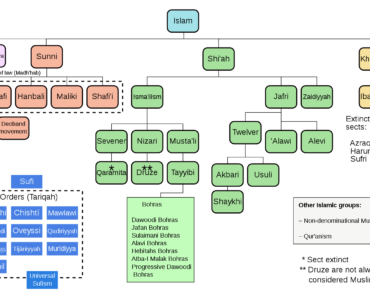
Muslims & Islam: Lesson 1

How Many Muslims Are There, And Where Do They Live?
Muslims make up about a quarter of the global population, making Islam the world’s second biggest religious group, after Christians. We estimate that in 2015, there were about 1.8 billion Muslims around the world, or 24 percent of the global population. By comparison, there were an estimated 2.3 billion Christians (31 percent) that year.

Muslims live in many different parts of the world. Although the religion is historically associated with the Middle East – whose population remains more than 90 percent Muslim — a majority of the world’s Muslims do not live in that region. In fact, the five countries with the largest Muslim populations -– Indonesia, India, Pakistan, Bangladesh and Nigeria -– are in Southeast Asia, South Asia and sub-Saharan Africa.
Muslims Are The World’s Fastest-Growing Major Religious Group

According to demographic projections, the Muslim population is expected to increase more than twice as fast as the world’s overall population, growing from 1.8 billion in 2015 to about 3 billion in 2060. The Muslim share of the global population also is projected to rise from 24 percent to 31 percent. Current trends indicate that in the second half of this century, Muslims will surpass Christians as the world’s largest religious group.
Fertility Rates And Young Populations Are Driving Muslim Growth.
The reasons for Muslim populations growth involve simple demographics: Muslims have more children than members of all other major religious groups we analyzed -– 2.9 children on average, compared with 2.6 children for Christians and 2.2 children for all non-Muslims combined.
The growth of the Muslim population also is boosted by the fact that Muslims have the youngest median age (24 in 2015) of all major religious groups, more than seven years younger than the median age of non-Muslims (32).
The projections also take into account the best available data on religious switching, or conversion, but this has a minimal impact on Muslim population growth. In many countries, there is little to no switching into and out of Islam. In other places, like the U.S., movement away from Islam is roughly canceled out by conversion into Islam.
The Muslim Population In Europe Is Increasing, But How Fast Depends On Immigration.
Europe experienced a record influx of asylum seekers fleeing conflicts in Syria and other predominantly Muslim countries in 2015 and 2016, prompting debate about immigration and security policies in numerous countries and raising questions about the current and future number of Muslims in Europe.
Muslims made up about 5 percent of all Europeans (defined as residents of the European Union plus Norway and Switzerland) as of 2016. That figure is projected to rise in the coming decades -– to more than 7 percent in 2050 — even in a hypothetical scenario in which all immigration to Europe stopped after 2016. This is largely because Muslims have higher fertility rates and a younger population compared with other Europeans.
.
Of course, this zero-migration scenario is unrealistic; immigrants have continued to arrive in Europe since 2016. The same is true of the other extreme: A scenario assuming that the refugee surge continues indefinitely (and that refugees in the future have the same religious composition), along with regular migration at rates similar to the recent past. In this case, Europe would be about 14 percent Muslim by 2050. But refugee flows into Europe have already dropped off substantially since 2016, meaning that a more realistic outcome is likely to be somewhere in between these two extreme bookends (7 percent and 14 percent).
How Many Muslims Are There In The United States.

The Muslim share of the U.S. population also has been rising — in part due to immigration -– but it is much smaller than in Europe. At the time of the most recent study of Muslim Americans in 2017, it was estimated that there were nearly 3.5 million Muslims of all ages in the U.S., or about 1 precent of the overall population.
There is still one other factor which contributes to the growth of Muslims, and that is polygamy. Islam is a polygamous religion. The Qur’an restricts it, but allows it in certain situations; Shari’a, Islamic law, allows for it; while illegal in the United States, it is believed some marriages are polygamous; a handful of countries allow, while some only permit it for Muslims. The point is, there are no records I can find which discuss polygamy when considering population projections. It is a factor, but most likely, a small one.
We’ll take a closer look at Muslim Americans in a future post.
PLEASE FEEL FREE TO SHARE WITH OTHERS.
Up Next: Lesson 2
What do Muslims around the world believe?
Muslims are far from monolithic. Not only do they display tremendous ethnic and linguistic diversity, they also have varying perspectives on Islam’s relationship with politics and public life.
The Institute for the Study of Islam (ISI) is a nonpartisan fact-think-tank. Discerning-Islam.org is a current project of ISI. As a neutral source of data and analysis, ISI does not take or make policy positions.
Did a friend share this post with you? Sign up for the course. Subscribe to our newsletter, Tips Of The Iceberg, or visit our website at discerning-Islam.org for all things, ISLAM.
To subscribe to this free newsletter, please click HERE.
If you would like to provide financial support, please click HERE.
MUSLIMS & ISLAM: LESSON 1
3000 – 001
https://discerning-Islam.org
04/2022
See COPYRIGHT information below.



A planned takeover by any race, sect, or religion is frightening! Our country was founded upon the principle that all are free to enjoy their ideals as equal contributors to the greatness of one unified nation.
That’s exactly why I started this -— the website, seminars, newsletters -— there is a very small percentage of radical jihadists, but they are very well heeled and intent on a world take-over. Look what they are doing in Africa -— Nigeria, Kenya, Democratic Republic of Congo — and elsewhere. I have been ringing the bell of their Islamic Playbook —- but who listens.